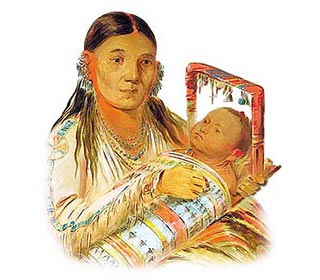This article about Native American Paint brings the Native American lifestyle literally to life, enabling a better understanding of the subject. Dream Catcher
Facts and history about the life and lifestyles of Native American Indians. The Native American Dream Catcher, or Dreamcatcher, was devised by the Woodland group of Native Indians as a protective charm or device, originally for the children of the tribes. The Dream catcher was believed to protect a person from the bad spirits that appeared in bad dreams and nightmares. The dream catcher was constructed in a spider web design using a wooden hoop that was attached to a woven web or loose net, so it looked like a spider's web. The dream catcher was then decorated with sacred and personal objects such as feathers and beads. Native American Life - Dream Catcher
The life, history and lifestyle of Native American Indians is a varied and fascinating subject. The following fact sheet contains interesting facts and information on Dream Catcher. Dream Catcher Fact Sheet for kids - Dream Catcher Fact 1: Purpose: The purpose of the Dreamcatcher was to catch good dreams "bawedjige" in the web and the bad dreams "Bawedjigewin" would fall through the web
- Dream Catcher Fact 2: Origin: The Dream catcher originated with the Chppewa (Objiwe) Tribe and was based on the legends, myths and creation story of the people.
- Dream Catcher Fact 3: Origin: The Chippewa (Ojibwe) people base the dreamcatcher on an ancient myth surrounding 'Asibikaashi', the Spider Woman who took care of the children and the people of the tribe.
- Dream Catcher Fact 4: Mothers and grandmothers would imitate Spider woman and her magical webs and weave webs for the children, using willow hoops and sinew, or cordage made from plants. Traditionally dreamcatchers were no wider than the width of the hand
- Dream Catcher Fact 5: The dream catcher was hung by a sleeping child as a protective charm to prevent nightmares, night terrors and other bad dreams.
- Dream Catcher Fact 6: Dreamcatchers were later adopted by other tribes who, with the introduction of the horse, migrated to the Great Plains to hunt buffalo. The Plains tribes adopted the new lifestyle and mixed with other nations through trade and adopting not only ideas regarding clothing but also some of the different cultures including the dreamcatcher
- Dream Catcher Fact 7: Origin: The Sioux tribe based their Dreamcatchers on the legend surrounding Iktomi a teacher of great wisdom who was also a great trickster and appeared in the form of a spider. Iktomi gave a dreamcatcher to a tribal elder telling him it that whilst he was sleeping the web would catch good ideas and dreams and the nightmares and bad ideas would fall through the hole. When a person woke the good ideas and dreams would be remembered
- Dream Catcher Fact 8: The purpose of the dreamcatcher was described by the Sioux tribe as follows: "Nightmares pass through the holes and out of the window. The good dreams are trapped in the web, and then slide down the feathers to the sleeping person."
- Dream Catcher Fact 9: Many believed that the power of dreamcatcher was so strong that it would trap other evil forces and bad spirits and provide protection against illness
- Dream Catcher Fact 10: It was traditional to attach a feather to the center of a baby's dreamcatcher and hang it on, or above, a bed or cradle board. They were hung in the tepee or outside on the branch of a tree.
- Dream Catcher Fact 11: The feather of an owl, representing wisdom, was hung from a girl's dreamcatcher. The feather of an eagle, representing strength and courage, was hung from a boy's dreamcatcher.
- Dream Catcher Fact 12: The Dreamcatcher was made from a wooden hoop, usually of willow, about 3½ inches in diameter. Sinew was attached to the hoop in spider web design.
- Dream Catcher Fact 13: Traditional dreamcatchers had small shells, as well as feathers, attached as ornaments. As time passed other ornaments such as glass beads or semi-precious stones were added
- Dream Catcher Fact 14: Larger sizes were later hung to ensure everyone to had good dreams
|
